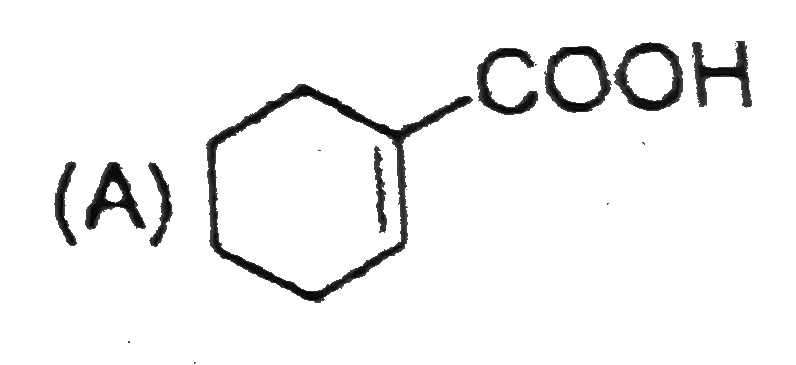X(i)KMnO4/H2O/Δ−−−−−−−−−−−−−→(ii)H3O⊕HOOC−O∣∣C−CH2−CH2−CH2−CH2−COOH
X may be




The correct Answer is:A
To solve the question, we need to determine the compound X that, when treated with potassium permanganate (KMnO4) in the presence of water and heat, leads to the formation of a specific dicarboxylic acid.
1. Identify the Product: The product given is a dicarboxylic acid with the structure HOOC-CO-CH2-CH2-CH2-CH2-COOH. This indicates that there are two carboxylic acid groups (-COOH) at the ends of a carbon chain.
2. Understand the Reagents: The reagent used is potassium permanganate (KMnO4), which is a strong oxidizing agent. It can oxidize alkenes to form diols and further oxidize them to carboxylic acids.
3. Determine the Structure of X: Since KMnO4 will oxidize an alkene, we need to consider that X must be a compound that can yield the dicarboxylic acid upon oxidation. The presence of two -COOH groups suggests that X should be a compound with a double bond that can be cleaved to form these groups.
4. Consider Possible Structures for X:
- A reasonable candidate for X is a compound that has a double bond between two carbon atoms, with sufficient carbon atoms on either side to allow for the formation of the dicarboxylic acid.
- A suitable structure could be a compound like 1,5-hexadiene, which has a double bond between the first and second carbon atoms.
5. Oxidation Mechanism: When 1,5-hexadiene is treated with KMnO4:
- The double bond will be oxidized to form a glycol (diol).
- Further oxidation will cleave the carbon-carbon bond, leading to the formation of two carboxylic acid groups at the ends of the carbon chain.
6. Final Structure Confirmation: After the oxidation and hydrolysis, the resulting structure matches the dicarboxylic acid given in the question.
7. Conclusion: Therefore, the compound X is likely to be 1,5-hexadiene or a similar alkene that can yield the specified dicarboxylic acid upon oxidation with KMnO4.
- A reasonable candidate for X is a compound that has a double bond between two carbon atoms, with sufficient carbon atoms on either side to allow for the formation of the dicarboxylic acid.
- A suitable structure could be a compound like 1,5-hexadiene, which has a double bond between the first and second carbon atoms.
- The double bond will be oxidized to form a glycol (diol).
- Further oxidation will cleave the carbon-carbon bond, leading to the formation of two carboxylic acid groups at the ends of the carbon chain.
Topper's Solved these Questions
Similar Questions
Knowledge Check
In the reaction sequence [X] is which ketone ?
[x]KmnO4/ϴOH/Δ−−−−−−−−−−→HOOC−(CH2)3−CH3∣CH−COOHA B
B C
C D
D
In the given reaction sequences the final product 'C' is
CH3−CH2−OH(i)KMnO4/−OH/Δ−−−−−−−−−−−−−−−→(ii)H2O+(A)(i)SOCl2−−−−−−−−→(ii)NH3(B)Br2/KOH−−−−−−→(C)
View SolutionCompound A on oxidation with hot KMnO4/¯¯¯OH given two compound CH3−CH∣CH3−COOHandCH3−O∣∣C−CH2−CH2−CH3. Compound A will have the structure
View SolutionFor the following acids the rate of decarboxylation on heating would be
I.CH6H5−O∣∣C−CH2−COOH (II)C6H5−O∣∣C−COOH
III.CH3−CH2−COOH IV.HOOC−CH2−COOH
View SolutionConsider the following reaction CH3−CH2(A)−O−H+CH3−O∣∣C(B)−OH→CH3−O∣∣C−O−CH2−CH3+HOH In the above reaction ester formation takes place by
View SolutionThe decreasing order of rate of reaction for the following compounds towards SN2Th (bimolecular nucleophilic substitution with tetrahedral intermediate) reaction is
(i) CH3−CH2−O∣∣C−NH2
(ii) CH3−CH2−O∣∣C−Br
(iii) CH3−CH2−O∣∣C−O−O∣∣C−CH2−CH3
(iv) CH3−CH2−O∣∣C−O−C2H5
View SolutionWrite the IUPAC names of the following compounds:
(i) CH3−CH3∣CH−CH3−CH2−O∣∣C−CH2Cl
(ii) H2C−COOH∣HO−C−COOH∣H2C−COOH
View SolutionConsider the following reaction (A)(i)O3−−−−−−−→(ii)H2O/ZnCH3−O∣∣C−CH2−O∣∣C−CH2−O∣∣C−CH3+3HCHO Compound 'A' will be
View Solution

